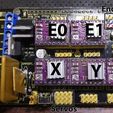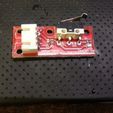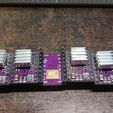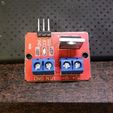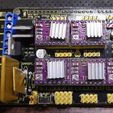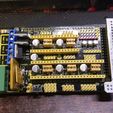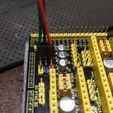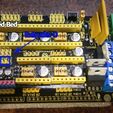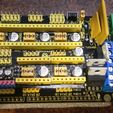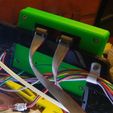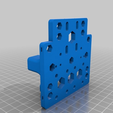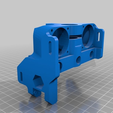So this one is all about wiring the RAMPS board. My other one about how to put Marlin on RAMPS and an Anet A8 is here: https://www.thingiverse.com/thing:2783450 Be sure to check it out!
If you download this thing it includes the carriage from https://www.thingiverse.com/thing:2766701
See the Octoprint and GPIO tutorial here! (https://www.thingiverse.com/thing:3372599)
See the Marlin Firmware tutorial here! (https://www.thingiverse.com/thing:2783450)
So first thing first this is as universal as a guide as I can do. It's packed with information I gathered working on my Anet A8. It was made with a $12 RAMPS 1.4 from Amazon.com and some equally as cheap DRV8825 stepper boards.
#I really recommend you use the RAMPS 1.6 now!
This is a pretty universal and recommended setup and I hope this guide helps you out!
#NEVER
work on electrical appliances with mains power attached.
#Unplug
, isolate and be sure that everything is safe before you begin.
On to it!
First step is to mount the RAMPS board to your Arduino.

This is the Arduino MEGA 2560 board. To mount your RAMPS to it just align the pins and gently push them together.
#Now
let's take a look at the RAMPS 1.4

Here in this poorly lit up-side-down picture is the colorful board I choose for my $12. It's cheap, made in China but it works. I'm not really saying you need this exact one or anything so feel free to choose any RAMPS 1.4,1.5 or 1.6 you wish. The difference is the 1.5 and 1.6 board has the MOSFETS surface mounted. This is better in my opinion because they get better heat dissipation and just aren't flappin' in the breeze as Dave Jones says.
#Install
stepper drivers
So let's install our stepper boards first. This guide is meant for the DRV8825 as seen here:

Here's my used, dirty DRV8825 boards. 5 of them since I have dual extruders. Take careful note of the direction they install. This is opposite the cheaper A4988 boards. Also these boards are higher resolution and require different jumper or firmware settings.

So the 1/16th step is the default setting in most cases and the maximum a A4988 can do. The 1/32 step is the maximum the DRV8825 can do and is more precise with slightly less torque. Not normally a worry in 3d printing.
This setting corresponds with the setting '#define DEFAULT_AXIS_STEPS_PER_UNIT {200, 200, 800, 200}' in your firmware. That example is for 1/32 steps on an Anet A8.
So with that covered and setup you can install the boards!
#Be
careful about the direction! Reversing the board can cause damage!

Notice the adjustment pots are to the left side in the photo, towards the input connector of the RAMPS board. This is opposite the A4988 boards.
#Now
it's time to connect some wires.

Have a look at this photo and lets start at the main power connector lower left. The upper part is the 11amp circuit for the heated bed and the lower part is the 6amp circuit for the hotends. I always use external MOSFETS and in most cases you can hook these together at the power supply. These are 12 volt connections.
The connections are from top to bottom:
- Positive12v 11amp
- Ground
- Positive 12v 6amp
- Ground
#Extruder
and bed connections
Above that connector is a set of 6 screw terminals for the hotends, fans and heat bed. These are not labeled negative and positive but generally the one closest to the power connector is positive. The heaters don't care about polarity but if you use the part cooling fan attachments you may need to check polarity.
These connections are from top to bottom:
- T0 / Extruder 1
- T1 / Extruder 2 or Part Cooling Fans for single extruder [never both! See below for more info on cooling fans with dual extruders]
- Heated Bed
The top one is for T0 / extruder 1. This is your primary heater in the extruder or the MOSFET for it.
Next is the T1 / Extruder 2 connection. This is used for the part cooling fans in a single extruder setup or extruder 2 in a dual extruder setup. Never attach both fans and an extruder here. See below for more information.
Closest to the power connector you have the heated bed connection. Run this to your MOSFET for bed heat or to the bed if it is small and low wattage.
Above this connector is a few status LEDs.
Moving on to the steppers you see the axis marked on the stepper board. at the top right corner of each stepper driver on the RAMPS board is a 4 pin header. There is 2 for the Z axis. This is there you attach the stepper wires. They are not marked for direction so if you find axis backwards you can flip the connection or correct it in firmware.
Bottom center is the servo connections. These are not used commonly though if you have dual extruders the right most servo connection if for driving a MOSFET to run your cooling fans. They are also used for BLTouch connections.
#Endstops
Top right you have the connections for endstops. From bottom to top you have +5 volts, - ground and signal. Most setups expect the signal to be pulled down, or to have it shorted to - negative. This is again configurable in firmware.
For the endstops from left to right they are
- X min
- X max
- Y min
- Y max
- Z min
- Z max

Here's an endstop switch attached. Notice the position of the wires. From left to right they are Signal, Ground and Positive 5v.
For reference this is the endstop switch I use. It's a common one from Ebay or Amazon, I forgot.

#Thermal
Sensors
For our temperature sensors the connections attach to the pins after the Extruder 1 stepper controller. These do not have a polarity!

#Cooling
fan for dual extruders!
Now back to that Fan and MOSFET thing for dual extruders. The servo pins far right of the picture above are from top to bottom:
- D4
- Positive 5v
- Ground
For the MOSFET I like to use these cheap little 5amp Arduino compatible ones like below.

Besides being cheap they are ready to connect to an Arduino and have nice screw connections for the 12volt required by the fans. You hook them up as follows on the servo connector:
- SIG to D4
- VCC to Positive 5v
- GND to Ground
On the screw terminals it's:
- V+ to Fan Positive
- V- to Fan Ground
- VIN to +12v
- GND to Ground
- You cannot common the ground across these terminals.
When '#define MOTHERBOARD BOARD_RAMPS_14_EEB ' is selected in Marlin it will automatically switch the PWM signal for the fans to the Servo / D4 pins.
#LCD
Last we have the LCD and SD card connections. These commonly use whats called a Smart Adapter to connect to the RAMPS board. The adapter uses the long pin header along the right edge and the aux port below to connect to a pair of 10 conductor cables for ease of use.

Here you can see the Smart Adapter in white with the two 10 pin cables attached. These cables run up to your LCD.

There's my RepRap Discount LCD in a printed enclosure on my Anet A8.

And there's the back of it with the cables.
#Setting
motor drive current
#This
needs to be done with power applied to the RAMPS board.
#While
this is typically only 12 volts you can cause damage by shorting things out.
#Be
careful what you stick where!

The little thing in the circle is how you adjust the drive current. This is important to not burn up drives or motors, or just skip steps due to low power.
To find motor current use this formula: Current in Amps = VREF × 2
VREF can be found be measuring between the point marked in the red circle and GND of the 12v power input.

Here you can see my VREF at 0.66 volts. This gives a current of 1.32amps at the motor. Since I have 1.5amp motors this works really well.
The easy way to set this is to connect the GND of your meter to the GND of your power supply somewhere close to the RAMPS board.
Then hold or clip your positive meter lead to the shaft of a small Philips screwdriver that fits the pot as shown below.

I'm just using my fingers to hold the probe to the shaft to read the voltage as the pot is turned.
And that's it, the current is now set!
#To
flash your firmware see https://www.thingiverse.com/thing:2783450
For more information and the links I got my info from see below:
- https://www.thingiverse.com/thing:2783450
- http://3d-maker.info/switching-to-ramps-1-4-wiring-anettronxy/
- http://reprap.org/mediawiki/images/6/6d/Rampswire14.svg
- http://reprap.org/mediawiki/images/3/3f/Arduinomegapololushieldschematic.png
- http://www.reprap.org/mediawiki/images/0/06/RAMPS_dossier.pdf
- https://makershopbcn.com/en/product/drv8825-stepper-driver-pololu-2
- http://reprap.org/wiki/A4988_vs_DRV8825_Chinese_Stepper_Driver_Boards
- http://www.instructables.com/id/Installing-and-Configuring-DRV8825-Stepper-Drivers/
- http://www.geeetech.com/wiki/index.php/Ramps1.4
- http://reprap.org/wiki/RepRapDiscount_Full_Graphic_Smart_Controller
- https://www.pololu.com/product/2133
I think that pretty much wraps this up. I hope this helps, enjoy, like and share with your friends!
Thank you Thingiverse community!

/https://fbi.cults3d.com/uploaders/16051940/illustration-file/e0730540-ff6b-4319-868c-f68d66d12df2/ramps-labels.jpg)
